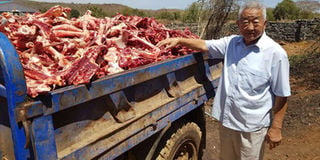Breaking News: Old Kijabe dam tragedy: Death toll rises to 45
Give me animal waste, and I’ll make you bone meal

Lu Donglin the managing director of Goldox Donkey Slaughterhouse in Mogotio, Baringo County displays fresh bones for making bone meal. Once boiled, the bone meal is safe for use and is more nutritious since it has protein, calcium and phosphorous. PHOTO | FRANCIS MUREITHI | NMG
What you need to know:
- Bone meal is an organic fertiliser that is a good source of phosphorus while for animals, it supplies mainly proteins.
- For the dry bones, they are crushed with some of the innards and boiled under high temperatures of between 350 and 400°C to kill any pathogens that include salmonella contaminants.
- The bones should be heated to temperatures of up to 400 degrees Celsius to curb diseases.
- The minerals in the bone meal such as calcium and phosphorous helps the animals to form a strong skeleton.
The 10-acre compound in Baringo County is busy each day, as farmers shepherd in their animals for weighing and medical check-up.
This is Goldox, a donkey slaughterhouse, which has turned the animal from a beast of burden to a livestock kept for meat.
However, the company run by Lu Donglin, a Chinese, is doing more. It is turning the tonnes of donkey bones into bone meal, an important ingredient that is used as organic fertiliser and for animal feed preparation.
Bone meal is an organic fertiliser that is a good source of phosphorus while for animals, it supplies mainly proteins.
“We export the bone meal to China and also sell locally to animal feeds manufacturers,” says Lu. At least 300-400 donkeys are slaughtered daily at the abattoir that employs more than 400 workers.
This means the firm ends up with tonnes of bones and other donkey by-products.
To make the bone meal, Lu explains that it all starts with drying fresh bones in the sun to remove water and blood.
On the other hand, the animal innards like liver, intestines and lungs are cooked under high temperatures and later dried in the sun. A huge chunk is sold to a Korean investor who rears crocodiles.
For the dry bones, they are crushed with some of the innards and boiled under high temperatures of between 350 and 400°C to kill any pathogens that include salmonella contaminants.
Thereafter, the powder is cooled and packed into 50kg bags that go for Sh750.
“Once boiled, the bone meal is safe for use and is more nutritious since it has protein, calcium and phosphorous.”
SUBJECTED TO HIGH TEMPERATURES
The product is mixed with other ingredients like whole maize, maize germ, cotton seed cake and soya beans to make chicken feeds, for instance.
The investor says the production capacity of the Sh300 million slaughterhouse is 15-20 tonnes of bone meal per day.

Lu inside the storage facility in his establishment. Bone meal is an organic fertiliser that is a good source of phosphorus while for animals, it supplies mainly proteins. PHOTO | FRANCIS MUREITHI | NMG
“My plan is to expand the bone meal facility so that it can crush more since the market for the product is huge both in Kenya and abroad,” says Lu.
Dr Anthony King’ori, a livestock production expert at Egerton University, says recycling the waste materials is not only beneficial for the environment, it also prevents substantial loss of income for the investor.
“The recycling cleans the environment since one would not find the bones strewn all over interfering with germination of grass and other plants. It takes a long time for the bones to biodegrade.”
Dr King’ori says meat and bone meal is an excellent source of protein, calcium, phosphorous, Vitamin B-12 and numerous other minerals that are necessary to an animal’s health.
“The minerals in the bone meal such as calcium and phosphorous helps the animals to form a strong skeleton.”
However, he warns that the bones must be subjected to high temperatures to sterilise any pathogens.
“The bones should be highly heated to temperatures of even up to 400°C so that they do not become an avenue of transmitting donkey diseases such as arthritis (inflation of joint), hoof deformity, liver diseases, and chronic obstructive pulmonary among others to animals,” said Dr King’ori.




